Introduction
Angelonia is a beautiful and versatile plant that has become increasingly popular in gardening and landscaping. With its vibrant colors and unique features, Angelonia is a great addition to any garden or landscape. In this comprehensive guide, we will provide you with all the information you need to know about Angelonia, from its physical characteristics and ideal growing conditions to its various uses in ornamental and medicinal applications. So, whether you are a seasoned gardener or just starting out, this guide will help you cultivate and use Angelonia to its fullest potential.
To begin with, let’s take a closer look at the appearance and physical characteristics of Angelonia.
Description
Angelonia, also known as summer snapdragon, is a herbaceous plant that belongs to the family Plantaginaceae. It is native to Mexico, the West Indies, and South America, but is now widely cultivated around the world. The flowers is a popular choice for gardeners and landscapers due to its striking colors and unique features.
Appearance and Physical Characteristics
Angelonia grows up to 18-24 inches tall and 12-18 inches wide, with a bushy and compact growth habit. Its leaves are lance-shaped, glossy, and dark green, with serrated edges. The flowers are arranged in upright spikes, and come in a range of colors, including pink, purple, blue, white, and lavender. The flowers are small, tubular, and have a snapdragon-like appearance, hence the common name “summer snapdragon”.
Ideal Growing Conditions for Angelonia
Angelonia grows best in full to partial sun and well-drained soil. It is a heat-loving plant that prefers high humidity and warm temperatures. This flower is also drought resistant and can withstand periods of drought. When grown properly, these flowers can bloom from late spring to late fall, adding vibrant color and beauty to any garden or landscape.
Types of Angelonia Plants
There are several varieties of Angelonia plants, each with its own unique features and characteristics. Some of the most popular varieties include:

Angustifolia: This is the most common species and is often referred to as “summer snapdragon.” It has narrow leaves and produces spikes of flowers in shades of pink, purple, and white. It is a compact plant that grows to about 12-18 inches tall.
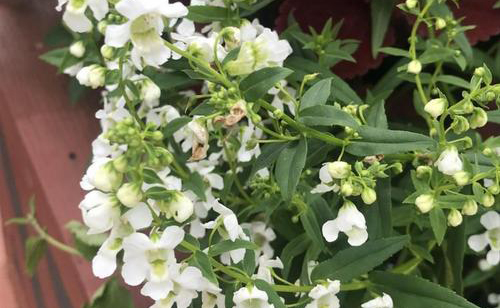
Archangel: This series is known for its large, showy flowers in shades of pink, purple, and white. It has a more upright growth habit than other varieties and can reach heights of up to 30 inches.
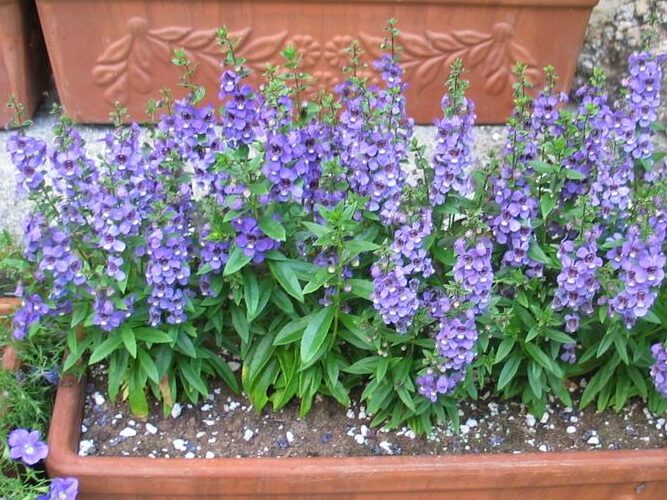
Serena: This series of Angelonia is known for its compact growth habit and prolific blooms. It produces spikes of flowers in shades of pink, purple, and white and grows to a height of about 12-14 inches.

‘Alonia Big Indigo’: This variety of Angelonia has deep blue-purple flowers and a more upright growth habit than other varieties. It can reach heights of up to 24 inches and is a great choice for adding vertical interest to a garden or landscape.

‘Serena White’: This variety of Angelonia produces spikes of pure white flowers and has a compact growth habit. It is a great choice for adding contrast to a garden or landscape and grows to a height of about 12-14 inches.
Overall, there are many different varieties of Angelonia plants to choose from, each with its own unique features and characteristics.
Cultivation
With the right care and upkeep, angelonia is a reasonably simple plant to grow and may flourish in a range of growth environments. In this section, we’ll go over how to grow Angelonia, including how to prepare the soil, how to plant, how much water and fertilizer to use, how to prune and deadhead, and how to control pests and diseases.
Soil Preparation and Planting Techniques
Angelonia prefers organically rich, well-drained soil. It is crucial to loosen the soil to a depth of 6 to 8 inches prior to planting in order to increase its fertility. Compost or other organic matter can also be added. Both seeds and transplants can be used to grow angelonia. When starting from seed, it is best to do so indoors six to eight weeks before the last date for frost and to move seedlings outside once all frost danger has passed. To allow for healthy growth and development, plant transplants 8 to 12 inches apart.
Watering and Fertilization Requirements
Angelonia requires regular watering to maintain healthy growth and vibrant blooms. It is important to water deeply and thoroughly, but avoid overwatering, as this can lead to root rot and other problems. This flowers also benefits from regular fertilization, especially during the growing season. Use a balanced fertilizer every 2-3 weeks to provide the necessary nutrients for healthy growth and flowering.
Pruning and Deadheading Techniques
Pruning and deadheading are important aspects of maintaining the health and beauty of Angelonia. Regular pruning helps to promote bushy growth and prevent legginess, while deadheading helps to promote continuous blooming. To prune Angelonia, simply pinch back the tips of the stems to encourage branching. To deadhead, remove spent flowers by cutting them back to the nearest set of leaves or flower buds.
Pest and Disease Management for Angelonia
Angelonia is generally resistant to pests and diseases, but it can still be affected by certain problems, such as spider mites, aphids, and powdery mildew. To prevent these problems, it is important to maintain good sanitation practices, such as removing dead or diseased plant material and keeping the area around the plant clean and free of debris. If pest or disease problems do occur, treat them promptly with an appropriate insecticide or fungicide.
Uses of Angelonia
Angelonia plants are highly versatile and can be utilized in various ways, both ornamental and medicinal. Moreover, they have other potential applications as well. Here are some of the most common uses of this flowers:
Firstly, this flowers is primarily grown for its ornamental value. It is a popular choice among gardeners and landscapers due to its vibrant colors and unique features. It can be used as a border plant, in containers, as a groundcover, or even as a cut flower. Its long-lasting blooms and heat tolerance make it a great choice for summer gardens and landscapes.
Secondly, this flowers has a long history of medicinal use in traditional medicine. Its leaves and flowers are rich in essential oils and other compounds that have been used to treat a variety of ailments, including respiratory infections, digestive problems, and skin conditions.
Thirdly, Angelonia’s essential oils have been used in the production of perfumes and other fragrances due to their pleasant aroma. Additionally, Angelonia seeds have been used as a source of oil for cooking and other purposes.
Lastly, Angelonia has potential as a biofuel crop due to its high oil content and fast growth rate. This makes it a promising candidate for the production of biofuels.
Conclusion
This flower, is a lovely and adaptable plant that can add color and vibrancy to any garden or landscape. Gardeners and landscape designers alike favor Angelonia because of its distinctive qualities and ease of cultivation. Angelonia is unquestionably something to think about, whether you want to use it in your garden for its ornamental value, investigate its medicinal qualities, or even think about its potential as an industrial crop. Angelonia can grow successfully in a variety of growing environments and provide long-lasting blooms and beauty for years to come with the right care and maintenance.

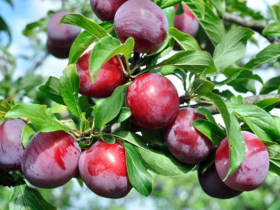
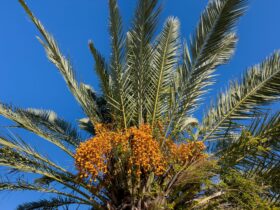
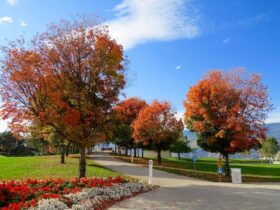
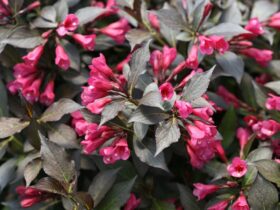
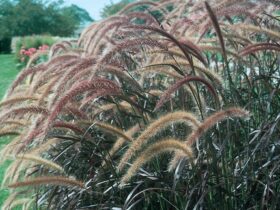
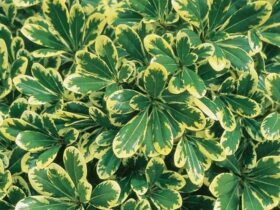

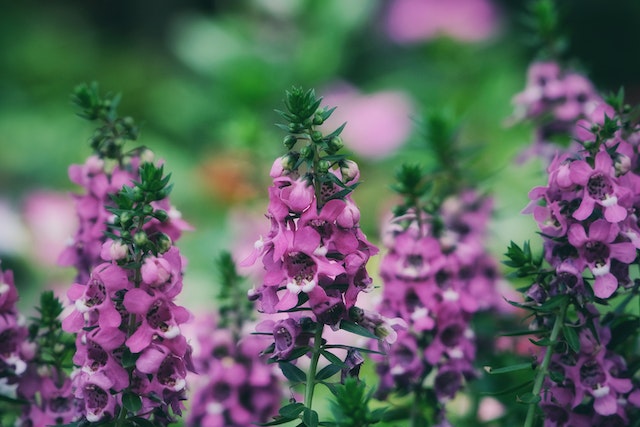


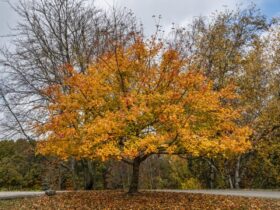

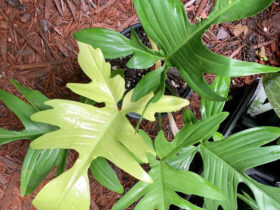
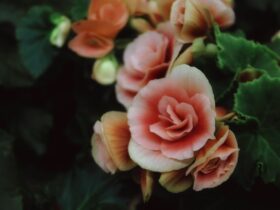
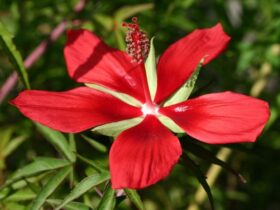
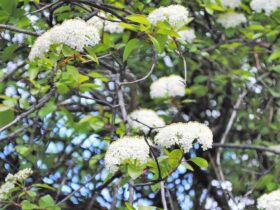
Leave a Reply